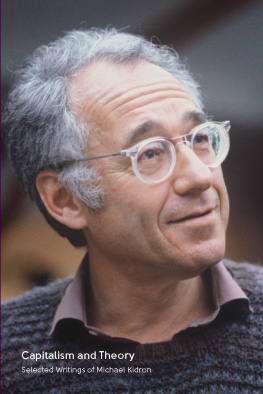First published 1997 by Ashgate Publishing
Reissued 2018 by Routledge
2 Park Square, Milton Park, Abingdon, Oxon, 0X14 4RN
711 Third Avenue, New York, NY 10017, USA
Routledge is an imprint of the Taylor & Francis Group, an informa business
Copyright Michael Bloor 1997
All rights reserved. No part of this book may be reprinted or reproduced or utilised in any form or by any electronic, mechanical, or other means, now known or hereafter invented, including photocopying and recording, or in any information storage or retrieval system, without permission in writing from the publishers.
Notice:
Product or corporate names may be trademarks or registered trademarks, and are used only for identification and explanation without intent to infringe.
Publishers Note
The publisher has gone to great lengths to ensure the quality of this reprint but points out that some imperfections in the original copies may be apparent.
Disclaimer
The publisher has made every effort to trace copyright holders and welcomes correspondence from those they have been unable to contact.
A Library of Congress record exists under LC control number: 97073458
ISBN 13: 978-1-138-35198-1 (hbk)
ISBN 13: 978-0-429-43492-1 (ebk)
Contents
Michael Bloor
Michael Bloor
Michael Bloor
Michael Bloor
Michael Bloor
Michael Bloor and Neil McKeganey
Michael Bloor and James McIntosh
David Silverman and Michael Bloor
Neil McKeganey and Michael Bloor
Michael Bloor
Michael Bloor, Marina Barnard, Andrew Finlay and Neil McKeganey
W.H. Auden, who knew a thing or two about writing, quoted approvingly an Icelandic proverb: Every man likes the smell of his own farts (Auden 1971, p.278). This a (robust) warning to authors that they are not necessarily the best judges of the relative merits of their various works. So the opportunity to select ones own Greatest Hits volume (an opportunity which gives new meaning to the phrase vanity publishing) is also a difficulty. The difficulty would be the same whether it were John Lennons Greatest Hits or Crispian St. Peterss Greatest Hits: its a relative ranking problem. Accordingly, I have followed several principles (rather just than my nose) in selecting ten papers for reprinting from around a hundred candidate previous publications. I have ruled out some papers, most obviously review articles, which seem to me to be hopelessly out-of- date. I have chosen some papers which have been quite widely cited. I have chosen some others which I have been told have merit but which are rarely seen except via the good offices of the Inter-Library Loan Scheme. And finally, I have selected a few which the world has completely disregarded, but for which I retain a sneaking affection: heres hoping that a turkey or two gets airborne. For obvious reasons, Im not going to identify my turkeys.
The chosen papers, chronologically ordered, embrace reports of research findings, discussions of research methods and discussions of theory. But they nevertheless have a degree of thematic unity, insofar as all the research reports engage in middle range theorizing and all the methods papers and theory papers draw extensively on empirical examples. The critical discussion of ethnomethodology () is perhaps an exception to this rule of unity. But as every ethnomethodologist knows, all rules are defeasible.
All the research reports (and all the empirical examples in the discussions of theory and methodology) are drawn from qualitative studies in medical sociology. Qualitative studies for the obvious reason that this book appears in the series of Cardiff Papers in Qualitative Research. And medical sociology because, since I graduated from the old M.Litt. course in Medical Sociology at Aberdeen more than 25 years ago, I have always worked as a medical sociologist - for most of that time, as a full-time researcher.
The days of the lone researcher are passing. Much of my own research work has been collaborative and the fact that half of these papers are coauthored is some reflection of the debt that I owe to many different coresearchers. For permission to reprint the co-authored papers, I am particularly grateful to my various co-authors: Marina Barnard and Neil McKeganey, both at the Scottish Centre for Drugs Misuse Research, University of Glasgow; Andrew Finlay, at Trinity College, Dublin; Jim McIntosh, at the Department of Social Policy and Social Work, University of Glasgow; and David Silverman, at Goldsmiths College, University of London.
Thanks are also due to the editors of the Cardiff Papers series, Paul Atkinson, Amanda Coffey and Sara Delamont, to Anne Keirby, the editorial administrator at Avebury, and to Jackie Swift who prepared the camera-ready copy with great efficiency.
Turning to the individual papers, (Bishop Berkeley and the Adeno-Tonsillectomy Enigma: an exploration of variation in the social construction of medical disposals, Sociology, vol. 10, pp. 43-61, Bloor, M. (1976)) is a report of one of the first observational studies of doctor-patient encounters undertaken in the UK, an analysis of nearly 500 different cases of children referred to Ear, Nose and Throat (ENT) Out-Patient Clinics for specialist opinion on the need for adeno-tonsillectomy (removal of the tonsils and adenoids, separately or conjointly). It was my first major research project and was also written up, part-time, for my PhD. The analysis aims to provide a phenomenological description of routinized medical decision-making which could also apply to other types of routinized decision-making outside of medicine. There was a rather sniffy attitude among some sociologists twenty years ago that medical sociology was not quite kosher and it was thought to be rather difficult to publish it in mainstream sociology journals. So in order to try and make it more acceptable to Sociology, I gave it an arch title (rather than, say, Variations in Assessments in ENT Out-Patient Clinics) and a rather over-written introduction (consider the phrase chestertonian whimsicality, for instance?). For permission to reproduce it here, I am grateful to the editors of Sociology, to BSA Publications Ltd (who have the copyright) and to their publishers, Cambridge University Press.
(On the Analysis of Observational Data: a discussion of the worth and uses of inductive techniques and respondent validation, Sociology, Vol.12, pp.545-52, Bloor, M. (1978)) was an account of some aspects of the methodology of the same study. I have reproduced it here because the first part of the paper contains a discussion and extended illustration of the method of analysis known as analytic induction or deviant case analysis. The paper has been discussed at length in various methods textbooks (e.g. Hammersley and Atkinson 1995, Silverman 1993). Analytic induction was hardly my invention (it had been briefly fashionable among American criminologists in the 1950s) but my paper has helped to popularize the technique as a method for














